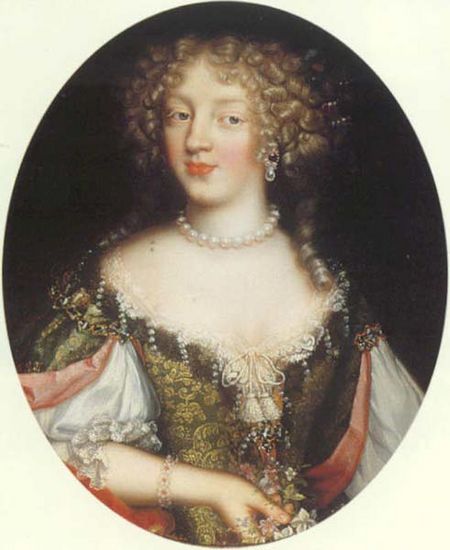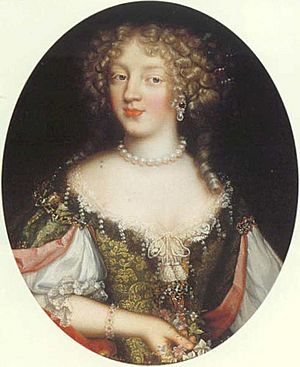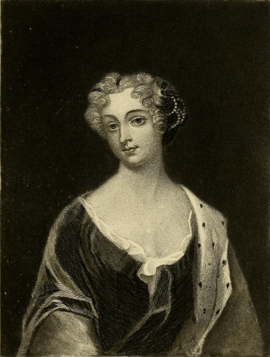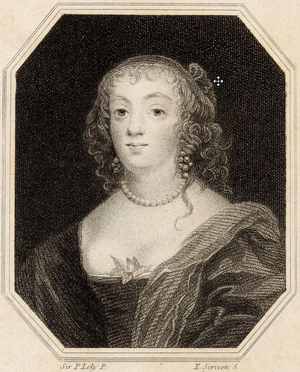Frances Talbot, Countess of Tyrconnell facts for kids
Quick facts for kids
Frances Talbot
|
|
|---|---|
| Countess of Tyrconnell | |
|
Detail from the portrait below
|
|
| Born | c. 1649 Sandridge, Hertfordshire, England |
| Died | 6 March 1731 Dublin |
| Spouse(s) |
|
| Issue Detail |
Elizabeth, Frances, Mary, & others |
| Father | Richard Jennings |
| Mother | Frances Thornhurst |
Frances Talbot, Countess of Tyrconnell (born Jennings, later Hamilton; around 1649 – 1731) was a famous beauty at the English court. She was known as La Belle Jennings. Frances was a maid of honour to the Duchess of York. Her sister, Sarah, was also very well-known. Frances first married George Hamilton and then Richard Talbot, Earl of Tyrconnell. She lived in Dublin Castle when her second husband was the Lord Deputy (like a governor) for King James II. Frances faced many challenges after her second husband died, but she managed to get some of his wealth back. She was raised as a Protestant but became a devoted Catholic later in life.
Contents
Early Life and Family
Frances Jennings was born around 1649 in Sandridge, Hertfordshire, England. She was the third of nine children born to Richard Jennings and Frances Thornhurst. Her father owned land and was a Member of Parliament (MP). This meant he helped make laws for the country. Her grandfather was also an MP. During the English Civil War, her father supported the Parliament.
Frances's mother was the daughter of Sir Gifford Thornhurst. Frances's parents married in 1643. Out of their nine children, Frances and her younger sister Sarah became famous. Sarah later became the Duchess of Marlborough.
Here are Frances and her siblings:
- Susanna (1645–1655), who died young.
- John (around 1647 – 1674), who took over from his father.
- Frances (around 1649 – 1731), the subject of this article.
- Barbara (1651/2– 1678), who married Edward Griffith.
- Richard (1653–1654), died as a baby.
- Richard (1654–1655), died as a baby.
- Susanna (1656–1657), died as a baby.
- Ralph (1656–1677).
- Sarah (1660–1744), who married John Churchill, 1st Duke of Marlborough.
Frances's family name was spelled in different ways during her lifetime, including Jennings, Jenings, and Jenyns.
Life at the Royal Court
Frances Jennings was about 11 years old when the Restoration (1660) happened. This was when King Charles II returned to the throne after a period without a king. In 1664, when she was about 15, Frances became a maid of honour to Anne Hyde. Anne was the Duchess of York and the first wife of James, Duke of York. James was the King's younger brother and would later become King James II.
Frances was so beautiful that people called her "La Belle Jennings" (which means "The Beautiful Jennings"). A writer named Macaulay described her as "beautiful Fanny Jennings, the loveliest coquette in the brilliant Whitehall of the Restoration". She is also mentioned in the Mémoires du comte de Grammont (Memoirs). This book was written by Antoine Hamilton, who was the younger brother of her future husband, George Hamilton. The Memoirs describe life at the royal court during that time. George and his two older brothers, James and Anthony, were close to the King. They were fashionable young men who had been with the King when he was in exile.
There's a fun story about Frances from the Memoirs and Pepys's diary. Frances and her friend, Miss Price, wanted to visit a fortune-teller without being recognized. So, they dressed up as orange sellers!
The Duke of York, who later became King James II, was interested in Frances. He thought his wife's maids of honour should be interested in him. But Frances refused to be involved in such a way. She was also courted by Richard Talbot and by George Hamilton.
First Marriage and Children
In 1665, Frances Jennings married George Hamilton. At that time, George was an officer in the Life Guards, a special army unit. The King seemed to care about his Catholic friends in the army. He gave Frances and George a yearly payment of £500. Their marriage is one of the last stories told in the Memoirs, written by George's brother, Anthony Hamilton.
Their first child, Elizabeth, was born in 1667. She was baptized on March 21 at St Margaret's, Westminster, in an Anglican (Protestant) ceremony.
On September 28, 1667, all Catholic soldiers were removed from the Life Guards. So, George Hamilton went to serve in the French army. Frances went with him to France and became a Catholic.
In 1671, George Hamilton gathered a group of soldiers in Ireland. He then served in the French army under famous generals like Turenne and Condé. In France, her husband was considered a count, so Frances became Countess Hamilton.
Frances and George had six children, but only four daughters are well-known:
- Elizabeth (1667–1724), who married Richard Parsons, the 1st Viscount Rosse, in 1685. She was the mother of Richard Parsons, 1st Earl of Rosse.
- Frances (died 1751), who married Henry Dillon, 8th Viscount Dillon, in 1687.
- Mary (1676–1736), who married Nicholas Barnewall, 3rd Viscount Barnewall, in 1688.
- Henrietta, who was likely younger than her sisters. Not much is known about her.
Elizabeth, the oldest daughter, was born in England and baptized as a Protestant. She married Viscount Rosse, a Protestant who was loyal to King James II. Her husband was one of the few Protestant members of the Irish House of Lords in the Parliament called by King James II in 1688. Frances and Mary, the younger daughters, were born in France and baptized as Catholics. They both married Catholic men. Henrietta does not seem to have married.
In June 1676, George Hamilton was killed by a musket shot during a battle in France. Frances became a widow. On July 7, King Charles II made her Baroness Rosse and Countess of Bantry for the rest of her life.
Second Marriage and Royal Connections
In 1681, Frances married again in Paris. Her second husband was Richard Talbot, an old suitor whom she had turned down before. Her husband was appointed Lord Deputy of Ireland (like a viceroy or governor). Frances and Richard lived in Dublin. He greatly increased the size of the Irish Army, changing it from mostly Protestant to mostly Catholic. In 1685, Talbot was given the title Earl of Tyrconnell in Ireland, and Frances became Countess of Tyrconnell.
In 1688, during the Glorious Revolution, King James II left England. Queen Mary and King William took his place. However, in 1689, King James II landed in Ireland, hoping to get his kingdoms back. Soon after he arrived, on March 20, 1689, he made Tyrconnell a duke. This meant Frances became a duchess. This title was part of the Jacobite peerage, which was given by King James II after he lost his throne. Even so, Frances is often called the Duchess of Tyrconnell. They did not have any children together.
In 1690, after King James II lost the Battle of the Boyne, he fled to Frances and Richard's home. Frances met him there. It is said that King James remarked, "Your countrymen, madam, can run well." Lady Tyrconnell cleverly replied, "Not quite so well as your majesty, for I see that you have won the race."
In August 1690, Lady Tyrconnell fled to France with her daughters and 40,000 gold coins. She became one of the ladies-in-waiting for Mary of Modena, the exiled Queen of England, at the Château of Saint-Germain-en-Laye. Her husband stayed in Ireland and died during the Siege of Limerick on August 14, 1691.
Later Life and Legacy
After her husband's death in 1691 or 1692, Frances was allowed to visit England. She wanted to get back the Irish lands that had been promised to her when she married Tyrconnell. These lands had been taken away after he was declared a traitor in 1689. During this visit to London, because she needed money, she reportedly had a dressmaker's stall at the New Exchange in the Strand area of Westminster. She dressed in white with her face covered by a white mask and was called "the white milliner." This story was made into a play in 1841 called "The white Milliner: A Comedy in two Acts."
Lady Tyrconnell returned to France. In 1693, she was accused of high treason herself. However, after Queen Anne became queen in 1702, Frances and her stepdaughter, Charlotte Talbot, finally got their lands back in 1703. This was likely thanks to her sister Sarah's influence with the Queen. Eventually, Frances retired to a Dominican Convent in Channel Row, Dublin, living there from 1723–1724. She then built a house on North King Street and was allowed to start a Poor Clares convent there.
Death and Memorial
Frances died in Dublin in 1731 at the Poor Clares convent she had founded. She was buried on March 9 in St Patrick's Cathedral in Dublin.
She also paid for a special mass to be said every day forever at the chapel of the Scots College in Paris. This mass was for her soul and the souls of both her husbands. You can still see a memorial plaque on the wall of this church. The Latin words on the plaque translate to:
To God, most good, most great.
To the most famous and noble Lady
Frances Jennings,
Duchess of Tyrconnell,
Lady-in-waiting of the Queen of Great Britain,
a helper of this College,
who started a daily mass in this holy place
to be celebrated forever
for her soul and those of Sir George
Hamilton of Abercorn, knight
her first husband, and Sir Richard Talbot,
duke of Tyrconnell, Viceroy of Ireland,
her second husband.
She died on March 17, 1731.
May she rest in peace.
Since the memorial plaque is in France, it uses the date of her death according to the Gregorian calendar (March 17, 1731). This calendar was used in France since 1582. However, in England, the old-style date (March 6, 1731) was still used at that time. England adopted the Gregorian calendar later, in 1752.






